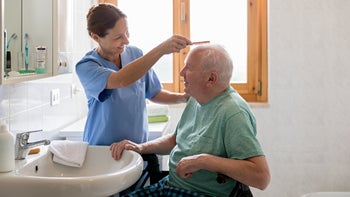
What’s the Best Medication for Overactive Bladder?
Key takeaways:
The only over-the-counter medication approved for overactive bladder (OAB) is Oxytrol for Women (oxybutynin). It's a patch that’s applied to your skin, but it should only be used by women.
The best prescription OAB medications are anticholinergics and beta-3 adrenergic agonists. Talk to your healthcare provider to find out more about which OAB medication may be best for you.
There are many ways to save on your OAB medications. GoodRx can help make your prescription more affordable. You can access Toviaz at an exclusive cash price of $200.10 with a free GoodRx discount. Manufacturer savings cards and patient assistance programs are also available.
Table of contents
You may recognize the signs of overactive bladder (OAB), especially if you're one of the 33 million U.S. adults who are all-too-familiar with it. The thought of needing to go to the bathroom suddenly without warning can control how you move about your day. It may even cause feelings of anxiety.
If you have OAB and aren’t sure why, you may want to pay a visit to your healthcare provider. OAB can have a variety of causes, some of which are simple to diagnose and treat. You could, for example, have a urinary tract infection (UTI) that can be treated with antibiotics to relieve your symptoms.
No matter the cause, not having control over your bladder can be both frustrating and disruptive. But you’re in luck — OAB can often be treated through lifestyle changes such as diet, pelvic floor exercises (Kegels), and bladder training. But, when needed, medications are also there for you to use.
In need of menopause symptom relief?
Get Premarin for over 55% less than the average retail price with GoodRx.

In fact, both over-the-counter (OTC) and prescription medications are available that can provide relief. Let's dive into which bladder control medications may be best for you.
Over-the-counter overactive bladder medications
Many OTC medications and supplements are marketed for OAB. But not all of them are FDA-approved. Read along to see which OAB products are available to you without a prescription.
Herbal supplements
At one point, the CDC pointed out that up to 75% of people living with OAB take herbal supplements for symptomatic relief. Popular herbal supplements for OAB include:
Gosha-jinki-gan (GJG)
Hachi-mi-jio-gan (HE)
Buchu (Barosma betuline)
Cleavers (Galium aparine)
Cornsilk (Zea mays)
Horsetail (Equisetum)
However, no herbal supplements have been approved or widely recommended to treat OAB. Because there is limited research, we can't say for sure if herbal remedies work. There’s also a chance that they could interact with other medications that you may be taking.
Make sure to ask your healthcare provider if herbal supplements like these are OK for you to take.
Oxytrol patch
There is a medication patch available that’s FDA-approved to treat OAB. It’s available OTC to treat OAB in women as Oxytrol for Women. And, it’s available as a prescription-only version for men as Oxytrol. In both Oxytrol for Women and Oxytrol, the active ingredient in the patch is oxybutynin.
Oxybutynin is an anticholinergic medication that has a “drying” effect, so it can help keep your bladder in check. Once applied, Oxytrol for Women and Oxytrol patches will last for 4 days then it needs to be replaced. Only one patch should be applied at a time.
Side effects from Oxytrol can include mild redness or itching where the patch is applied. It can also cause other common anticholinergic side effects, such as dry mouth. But because Oxytrol patches have limited absorption, anticholinergic side effects are typically less common than its oral counterpart. We’ll discuss anticholinergic side effects more below.
Prescription overactive bladder medications
If you find that lifestyle changes Oxytrol patches are ineffective, don't worry. There are a number of FDA-approved medications that can help you manage your symptoms.
Anticholinergics
Anticholinergics are a group of medications that work by blocking a chemical in your body called acetylcholine. Acetylcholine normally tells your bladder muscles to contract, causing you to urinate. Blocking this chemical helps control your bladder contractions.
Commonly prescribed oral anticholinergics for OAB include:
Oxybutynin (Ditropan)
Tolterodine (Detrol, Detrol LA)
Fesoterodine (Toviaz)
Solifenacin (Vesicare)
Darifenacin (Enablex)
When medications are needed, oral anticholinergics are a first-choice treatment. Some anticholinergics are also available as extended-release (ER) formulations. This means the medication is released gradually over time. If an ER formulation is available, it’s usually preferred because it has a smaller risk of side effects, especially dry mouth.
Talk to your healthcare provider to see which formulation may be best for you.
Beta-3 adrenergic agonists
Beta-3 adrenergic agonists are a group of medications that work by activating receptors (chemical binding sites) in your bladder. They relax your bladder and allow it to hold more urine.
The two beta-3 adrenergic agonists available to treat OAB are mirabegron (Myrbetriq) and vibegron (Gemtesa).
In addition to anticholinergic medications, beta-3 adrenergic agonists are another possible first-choice treatment option. And because they work differently than anticholinergics, they can be taken together as a combination therapy in severe cases of OAB.
Is there a best medication for overactive bladder?
The prescription options are comparable to each other. The differences that make one better than the other are due to factors like side effects, cost, and other medical conditions you may have. We’ll discuss this more below.
Side effects of overactive bladder medications
While anticholinergics and beta-3 adrenergic agonists are helpful options for people with OAB, they can cause side effects.
Anticholinergics
The most common side effects of anticholinergics are:
Drowsiness
Blurry vision
Nausea
Anticholinergics have also been associated with a higher risk of dementia. For this reason, it’s recommended that anticholinergics be avoided in older adults if possible.
Beta-3 adrenergic agonists
The most common side effects of beta-3 adrenergic agonists are:
Elevated blood pressure
Constipation
Inability to empty your bladder
Dry mouth
Sinus irritation
Headache
Dizziness
Although both groups of medications may cause dry mouth, beta-3 adrenergic agonists carry a lower risk of it. Also, keep in mind that the risk of these side effects is dependent on the dose of medication.
Overactive bladder medication precautions
OAB medications aren’t right for everyone. People with the following health conditions should talk to their healthcare provider and take caution before using medications for OAB:
If you experience heart palpitations, irregular heart rhythms, or other electrical heart issues, it’s important to use medications with caution. Two OAB medications — solifenacin and tolterodine — cause QT prolongation which can worsen these symptoms. However, the ER formulation of tolterodine carries less risk of heart complications.
If you have kidney problems, you’ll likely have to take lower doses of trospium, tolterodine, fesoterodine, or solifenacin.
If you have liver problems, you’ll need to take a lower dose of darifenacin, solifenacin, or tolterodine. Fesoterodine shouldn’t be taken at all if you have severe liver problems.
If you live with glaucoma, urinary retention, or a gastrointestinal condition, you should avoid all anticholinergic medications in most cases.
How to save on overactive bladder medications
There are many ways to save on your overactive bladder medications. GoodRx can help you navigate your options, which may include GoodRx discounts, copay savings cards, and patient assistance programs.
Anyone with a valid prescription, regardless of insurance status, can use GoodRx to purchase a 30-day supply of Toviaz at an exclusive cash price of $200.10. You can also find generic overactive bladder medications for as low as $9 per month with a free GoodRx discount.
The bottom line
Fortunately, there are many ways to treat OAB. You can start with certain lifestyle changes to help relieve your OAB symptoms. But if lifestyle changes aren’t working for you, you could consider trying an OAB medication. The best OAB medications available are anticholinergics and beta-3 adrenergic agonists. Be sure to ask your healthcare provider if it’s safe to take them with your other potential medications and health conditions.
Why trust our experts?



References
Allergan, Inc. (2016). Oxytrol for Women [package insert].
American Geriatrics Society. (2019). American Geriatrics Society 2019 Updated AGS Beers Criteria® for potentially inappropriate medication use in older adults. Journal of the American Geriatrics Society.
American Urological Association. (2019). Diagnosis and treatment of non-neurogenic overactive bladder (OAB) in adults: An AUA/SUFU guideline.
Andersson, K. E. (2017). On the site and mechanism of action of β3-adrenoceptor agonists in the bladder. International Neurourology Journal.
Camber Pharmaceuticals, Inc. (2021). Tolterodine tartrate [package insert].
Chughtai, B., et al. (2013). Use of herbal supplements for overactive bladder. Reviews in Urology.
Graviti Pharmaceuticals Private Limited. (2022). Solifenacin succinate [package insert].
Kim, J. K., et al. (2022). β3-adrenoceptor agonist for the treatment of bladder dysfunction in children: A systematic review and meta-analysis. Journal of Urology.
Lam, S., et al. (2007). Pharmacologic management of overactive bladder. Clinical Interventions in Aging.
Leron, E., et al. (2017). Overactive bladder syndrome: Evaluation and management. Current Urology.
López-Álvarez, J., et al. (2019). Anticholinergic drugs in geriatric psychopharmacology. Frontiers in Neuroscience.
National Association for Continence. (2016). Overactive bladder care pathway infographic.
Padagis US LLC. (2021). Trospium Chloride [package insert].
Pfizer Inc. (2021). Toviaz [package insert].
Torrent Pharmaceuticals Limited. (2022). Tolterodine tartrate extended-release [package insert].
Torrent Pharmaceuticals Limited. (2022). Darifenacin extended-release [package insert].
Wani, M. M., et al. (2021). Comparison of antimuscarinic drugs to beta adrenergic agonists in overactive bladder: A literary review. Current Urology.
















